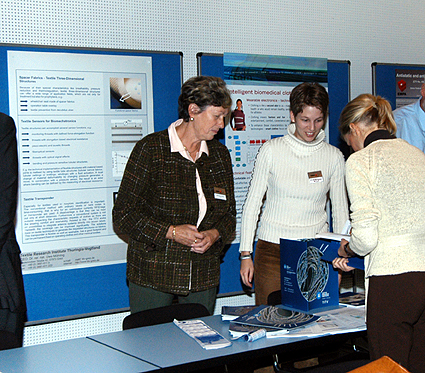8th Empa Meeting on Textiles: Medical Textiles
From the research laboratory to the patient
Textiles have many uses apart from clothing, and in addition to creating fashion items are used in various technical applications as well. One field in which technical textiles are becoming ever more important is medicine, and this was the subject of a one-day seminar held at the

|
A huge market for medical textiles Textiles find many different uses in the field of medicine, for example in articles of hygiene, as filters, bandages, support and protective material, surgical sutures and even as long term implants. The characteristics required of the textiles in question vary depending on the task for which they are to be used. Some applications demand a protective function, others a high absorptive capacity, yet others impermeability. Sometimes the textile is required to react neutrally towards the surface with which it is in contact, in other cases it must show particular behaviour such as releasing an active agent or stimulating growth in biological tissue by virtue of its structure or surface chemistry. And it is not just high-tech materials from the research laboratory which are required – textiles of simple cotton also have their place too. An enormous marketplace for industry, therefore, and one which in the USA alone has a value of about US$ 1.7 billion. Biocompatibility – an essential property The presentations at the Empa seminar considered many aspects of medical textiles, but one topic which frequently raised its head was biocompatibility. That the body’s cells tolerate foreign material, textile or otherwise, is not self-evident, and the Empa and various companies and hospitals are tackling this problem. There are many different ways of approaching the problem of making textiles biocompatible, that is tolerated by the body. Since the body’s cells actually only “see” the proteins adsorbed onto the surface of the foreign material, its surface structure or its elasticity, the type of surface in question plays a very important role. In the macro and microscopic context, this depends on the fineness of the weave of the textile used, whether it is made of synthetic or natural fibers, and whether it is in its natural state or has been chemically or physically modified. Surface coatings and the permeability of the surface are also important factors. Silver coatings, for example, have become established by virtue of their antibacterial properties. However, excessive silver desorption can have a negative effect on cells nearby, further underlining the importance of biocompatibility. Even the structure of the material at the nanoscopic scale can play a decisive role in determining the presence of positive or negative properties in terms of biocompatibility, as one speaker described. Poster presentations and the prize for the best poster The seminar discussed the possibilities and opportunities which are opening up, from research and development all the way to applications. Answers to the following questions were discussed: · Which basic materials are required? · What new technologies are available? · What role does material processing play? · Which are the most promising areas of application? · What problems arise in the implementation of the technology? Although the spectrum of topics and questions covered by the speakers was very broad, this was matched by the range of interests of the audience. In addition to manufacturers of special medical textiles, representative of the universities, research institutes, clinics and health authorities attended the seminar. The events offered an excellent opportunity for discussion and know-how-transfer between researchers and users in this very wide-ranging field. And for the first time at an Empa Textile Meeting there was a poster session. This attracted a good number of entries and further expanded the spectrum of ground covered. The best poster was, of course, awarded a prize, the winner being Marc Lawrence, a doctoral student at the ETH Zurich. Further information from Textiles: Hansruedi Schmid, Functional Fibers and
Textiles Lab, Tel. +41 71 274 73 48, Biocompatibility: Dr. Arie Bruinink, Biocompatible
Materials Lab, Tel. +41 71 274 7695 |
||
